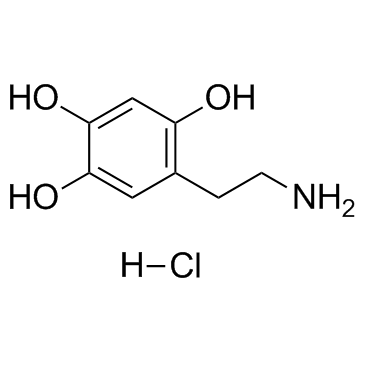Oxidopamine hydrochloride

Oxidopamine hydrochloride structure
|
Common Name | Oxidopamine hydrochloride | ||
|---|---|---|---|---|
| CAS Number | 28094-15-7 | Molecular Weight | 205.63900 | |
| Density | N/A | Boiling Point | 406ºC at 760 mmHg | |
| Molecular Formula | C8H12ClNO3 | Melting Point | 232-233ºC (dec.)(lit.) | |
| MSDS | Chinese USA | Flash Point | 199.3ºC | |
| Symbol |

GHS07 |
Signal Word | Warning | |
|
Gene therapy with AAV2-CDNF provides functional benefits in a rat model of Parkinson's disease.
Brain Behav. 3(2) , 75-88, (2013) Cerebral dopamine neurotrophic factor (CDNF) protein has been shown to protect the nigrostriatal dopaminergic pathway when given as intrastriatal infusions in rat and mouse models of Parkinson's disease (PD). In this study, we assessed the neuroprotective eff... |
|
|
Functional Role of the Disulfide Isomerase ERp57 in Axonal Regeneration.
PLoS ONE 10 , e0136620, (2015) ERp57 (also known as grp58 and PDIA3) is a protein disulfide isomerase that catalyzes disulfide bonds formation of glycoproteins as part of the calnexin and calreticulin cycle. ERp57 is markedly upregulated in most common neurodegenerative diseases downstream... |
|
|
LPA signaling is required for dopaminergic neuron development and is reduced through low expression of the LPA1 receptor in a 6-OHDA lesion model of Parkinson's disease.
Neurol. Sci. 36 , 2027-33, (2015) Lysophosphatidic acid (LPA) is a bioactive phospholipid that activates at least five known G-protein-coupled receptors (GPCRs): LPA1-LPA5. The nervous system is a major locus for LPA1 expression. LPA has been shown to regulate neuronal proliferation, migratio... |
|
|
Regenerative therapy in experimental parkinsonism: mixed population of differentiated mouse embryonic stem cells, rather than magnetically sorted and enriched dopaminergic cells provide neuroprotection.
CNS Neurosci. Ther. 20(8) , 717-27, (2014) The objective of the study was to develop regenerative therapy by transplanting varied populations of dopaminergic neurons, differentiated from mouse embryonic stem cells (mES) in the striatum for correcting experimental parkinsonism in rats.mES differentiate... |
|
|
Neurotensin-polyplex-mediated brain-derived neurotrophic factor gene delivery into nigral dopamine neurons prevents nigrostriatal degeneration in a rat model of early Parkinson's disease.
J. Biomed. Sci. 22 , 59, (2015) The neurotrophin Brain-Derived Neurotrophic Factor (BDNF) influences nigral dopaminergic neurons via autocrine and paracrine mechanisms. The reduction of BDNF expression in Parkinson's disease substantia nigra (SN) might contribute to the death of dopaminergi... |
|
|
Rho kinase inhibition by fasudil in the striatal 6-hydroxydopamine lesion mouse model of Parkinson disease.
J. Neuropathol. Exp. Neurol. 73(8) , 770-9, (2014) Chronic degeneration of nigrostriatal projections, followed by nigral dopaminergic cell death, is a key feature of Parkinson disease (PD). This study examines the neuroprotective potential of the rho kinase inhibitor fasudil in the 6-hydroxydopamine (6-OHDA) ... |
|
|
Curcumin I mediates neuroprotective effect through attenuation of quinoprotein formation, p-p38 MAPK expression, and caspase-3 activation in 6-hydroxydopamine treated SH-SY5Y cells.
Phytother Res. 28(4) , 611-6, (2014) 6-Hydroxydopamine (6-OHDA) selectively enters dopaminergic neurons and undergoes auto-oxidation resulting in the generation of reactive oxygen species and dopamine quinones, subsequently leading to apoptosis. This mechanism mimics the pathogenesis of Parkinso... |
|
|
Ameliorating effects of curcumin on 6-OHDA-induced dopaminergic denervation, glial response, and SOD1 reduction in the striatum of hemiparkinsonian mice.
Eur. Rev. Med. Pharmacol. Sci. 17(10) , 1360-8, (2013) Inflammation and oxidative stress are believed to contribute to neuronal degeneration of the nigrostriatal dopaminergic (DA) pathway in Parkinson's disease. Curcumin, a component of the yellow curry spice, has been reported possessing anti-inflammatory and an... |
|
|
Chronic deep brain stimulation of the medial forebrain bundle reverses depressive-like behavior in a hemiparkinsonian rodent model.
Exp. Brain Res. 233 , 3073-85, (2015) Preclinical and clinical evidence suggests that depression might be associated with a dysfunction in the reward/motivation circuitry. Deep brain stimulation (DBS) of the superolateral branch of the medial forebrain bundle (MFB) has been shown in a recent clin... |
|
|
Effects of squalene/squalane on dopamine levels, antioxidant enzyme activity, and fatty acid composition in the striatum of Parkinson's disease mouse model.
J. Oleo Sci. 62(1) , 21-8, (2013) Active oxygen has been implicated in the pathogenesis of Parkinson's disease (PD); therefore, antioxidants have attracted attention as a potential way to prevent this disease. Squalene, a natural triterpene and an intermediate in the biosynthesis of cholester... |